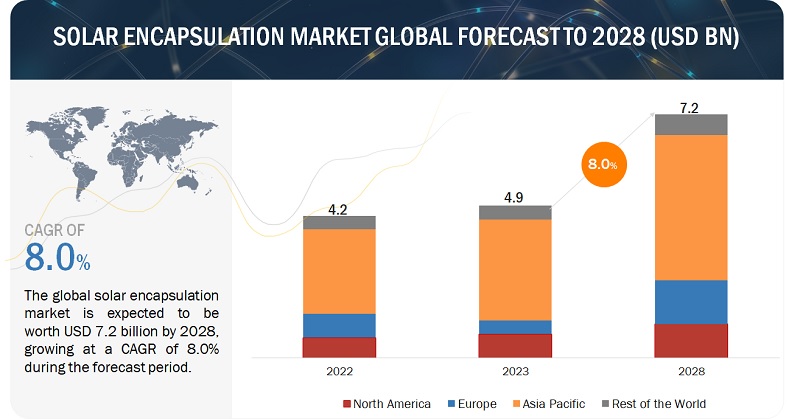New Revenue Pockets:
The global solar encapsulation market is projected to reach USD 7.2 billion by 2028 from an estimated USD 4.9 billion in 2023, at a CAGR of 8.0% during the forecast period. The growing use of electronic devices in emergency, off-grid, and automotive applications will benefit the solar encapsulation generator business. This report segments the solar encapsulation market based on materials into Ethylene-vinyl Acetate (EVA), Polyvinyl Butyral (PVB), Polydimethylsiloxane (PDMS), Ionomer, Polyolefin, Thermoplastic Polyurethane (TPU). EVA is an incredibly inexpensive material compared to alternative encapsulants, making it readily accessible and a clear choice for solar cell manufacturers aiming for widespread adoption. EVA forms strong bonds with both the glass cover and the back sheet of the solar module, creating a secure and stable environment for the delicate solar cells inside. Though the recycling of solar panels is still in its early stages, EVA possesses properties that make it potentially recyclable at the end of the module’s life, contributing to a more sustainable solar industry.
Download PDF Brochure – https://www.marketsandmarkets.com/pdfdownloadNew.asp?id=927
Based on the technology, the solar encapsulation market is segmented into crystalline silicon and thin-film solar technology. The crystalline silicon technology segment is further sub-segmented into mono-crystalline and polycrystalline silicon solar technology. The thin-film solar technology segment is sub-segmented into Cadmium telluride (CdTe), Copper-Indium-gallanium-selenide (CIGS) and Amorphous Silicone. Crystalline silicon solar technology is widely employed because of its high efficiency, longevity, and cost-effectiveness. Crystalline silicon solar panels are appropriate for a wide range of applications, including residential, commercial, and industrial use. They are simply installed on roofs or other surfaces, making them a versatile solution for a variety of needs. Crystalline silicon solar panels are comprised of silicon, which is abundant and has a smaller environmental impact than other materials used in solar cells.

This report segments the solar encapsulation market based on application into four categories: Ground-mounted, Building-integrated photovoltaics, Floating Photovoltaics and others. Thin-film solar panels are lightweight and flexible, making them suitable for a wide range of applications and building types. This technology has a higher spectrum absorption range, including more infrared and even some ultraviolet light, which can boost their efficiency in certain settings. Although thin-film solar panels are less durable than crystalline silicon panels, they provide dependable performance. The prices of thin-film modules are significantly cheaper than those of other technologies. However, they have lower module efficiency when compared to crystalline solar panels.
Ask Sample Pages – https://www.marketsandmarkets.com/requestsampleNew.asp?id=927
The solar encapsulation market based on region is segmented into North America, Europe, Asia Pacific, and the rest of the world. Europe is expected to hold the second-largest market share during the forecast period. Strengthening European climate conservation goals and growing environmental concerns have resulted in a greater emphasis on renewable energy sources, particularly solar power. The European market is expanding in a variety of locations, with significant participants including Germany, Spain, the Netherlands, and Italy. Government support, good legislation, and strong industrial relationships are driving regional growth.

